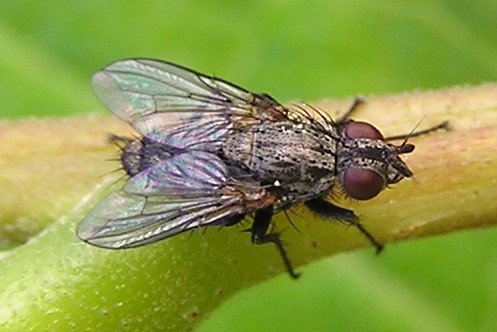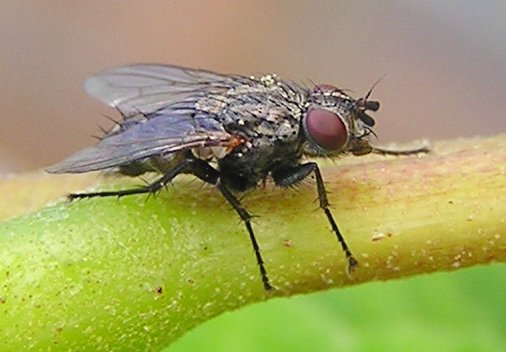Diptera.info :: Identification queries :: Diptera (adults)
|
Frauenfeldia rubricosa (Rhinophoridae)
|
|
| Michael Becker |
Posted on 23-09-2007 20:23
|
|
Member Location: Germany, Neuss Posts: 1268 Joined: 16.01.07 |
Hello, what type of tachinidae is this? Estheria? (found today in my garden in western germany.) Thanks, Michael Michael Becker attached the following image:  [41.63Kb] Edited by Michael Becker on 24-09-2007 18:23 |
|
|
|
| Zeegers |
Posted on 23-09-2007 21:24
|
|
Member Location: Soest, NL Posts: 19213 Joined: 21.07.04 |
Looks more like Frauenfeldia rubricosa (Rhinophoridae) Theo |
|
|
|
| jorgemotalmeida |
Posted on 23-09-2007 22:19
|
|
Member Location: Viseu - PORTUGAL Posts: 9296 Joined: 05.06.06 |
a perfect example that in Nature there are no rules.  It hasn't an evident petiole (I'd say better: there is no petiole) for this Rhinophoridae! I thought that there were no virtual exceptions for this rule in Rhinophoridae... I was wrong. |
| Michael Becker |
Posted on 24-09-2007 15:26
|
|
Member Location: Germany, Neuss Posts: 1268 Joined: 16.01.07 |
This was also the reason, why I was wrong again with the family. How can you distinguish this from a tachinid? Anyway - Thanks a lot for the identification, Michael |
|
|
|
| Xespok |
Posted on 24-09-2007 16:00
|
|
Member Location: Debrecen, Hungary Posts: 5551 Joined: 02.03.05 |
So far my best method, which is not fool-proof, is to look at how the fly behaves. Most larger Tachinids are quite docile, if not they fly away right away and rarely allow another shot. The smaller ones tend to fly away easier, and land somewhere out of your sight. Rhinophorids tend to be more nervous, but they hop around rather than stay at one place or fly away. Of course you need to put the behavior of the fly into your memory. Also Rhinophorids somehow look to me as smalll Dexiine Tachinids, they have relatievely long legs, but they are much smaller than Dexiini. I do not think this is fool-proof either. Gabor Keresztes Japan Wildlife Gallery Carpathian Basin Wildlife Gallery |
| Zeegers |
Posted on 24-09-2007 16:01
|
|
Member Location: Soest, NL Posts: 19213 Joined: 21.07.04 |
Michael.could you please change the title ? There is no rule that Rhinophoridae must have a petiole. Many don't. In this case, one first recognizes the species. IN general, the calyptrae are small in Rhinophoridae, large in Tachinidae (with a few exceptions). Impossible to see in this pic. Theo |
|
|
|
| Michael Becker |
Posted on 24-09-2007 18:33
|
|
Member Location: Germany, Neuss Posts: 1268 Joined: 16.01.07 |
Thank you for your answers. I see, I will confuse them in future too. Here is the only shot I have, on which the calyptrae are visible. The fly was really calm and didn't hop or fly - it was 9 AM and still rather fresh. Michael Michael Becker attached the following image:  [33.93Kb] |
|
|
|
| Jump to Forum: |













